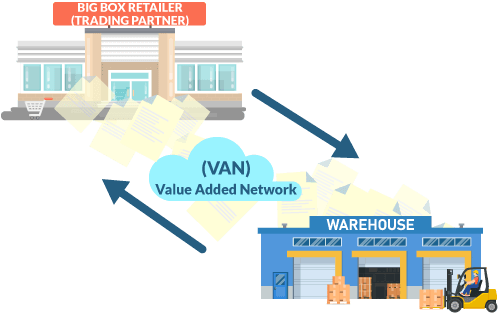What is EDI and How Does it Work?
Built For


- Basics of EDI
- Flow of data in the EDI process
- Role of EDI management software
- Critical components to operate EDI systems efficiently
- Benefits of using EDI
- Real-world case study of how EDI integration enhanced efficiency for a small business distributor
What is EDI and How Does it Work?

In the digital age, where every second counts and efficiency is the watchword, businesses continuously seek better ways to streamline their operations. Enter Electronic Data Interchange, or EDI—a business communication tool that has reshaped how transactions are handled across numerous industries.
At its core, EDI allows the computer systems of different companies to “talk” to each other directly, exchanging documents like invoices and purchase orders without human intervention. This powerhouse tool revolutionizes the speed, accuracy, and cost-effectiveness of business processes.
Let’s explore EDI and its functions and, by the end of this article, you will grasp its function and significant impact on modern business.
What is EDI?
Electronic Data Interchange, or EDI, might initially seem complex, but it’s essentially a system that enables businesses to exchange documents and information electronically in a standardized format. This means that companies automatically exchange information directly between their respective IT systems instead of sending paper forms through the mail or even emailing PDFs or Word documents.
The Basics
For companies connected via EDI, postal mail, fax, and email are mostly replaced with EDI transactions, as non-EDI communication methods require someone to handle the document on each end. EDI allows the entire process to be conducted in a streamlined, automated manner from one computer to another, reducing the risk of errors and significantly speeding up transaction times.
Historical Context
The roots of EDI go back to the 1960s when companies first began exploring ways to speed up document sharing. As technology advanced over the decades, so did the capabilities and complexity of EDI systems. Today, EDI is indispensable in many industries, including retail, manufacturing, and healthcare, because it supports the rapid, accurate, cost-effective transmission of everyday business transactions.
The Standardization of EDI
A key aspect of EDI’s effectiveness is its use of standardized formats. These standards, such as ANSI X12 in the United States and EDIFACT internationally, ensure that companies worldwide can communicate clearly and consistently, regardless of their internal software systems. This universality is crucial for enabling global trade and efficient supply chain management.
By automating data transmission and ensuring that everyone speaks the same digital language, EDI speeds up business processes and cuts costs by reducing the labor and errors associated with manual handling.
How Does EDI Work?

Understanding how EDI works is crucial for appreciating its efficiency and impact on business operations. The process involves several important steps and components, each vital in ensuring data flows seamlessly and securely from one party to another.
The EDI Process Flow
- Document Preparation: A business generates a document, like a purchase order, to initiate a transaction.
- Document Translation: This document is converted into a standardized EDI format using an EDI translator. This ensures the document can be universally understood, regardless of the specific IT systems of the involved parties.
- Document Transmission: The translated document is transmitted over a secure network to the trading partner. This can be done through communication protocols, such as a VAN (Value-Added Network).
- Receipt and Reconciliation: Upon receiving the document, the recipient’s EDI system automatically checks and processes it. Confirmation is sent back, and the cycle is completed.
EDI Management Software
EDI is powerful by itself, but when combined with EDI management software, it transforms into an even more dynamic tool. This software automates many tasks associated with order management and fulfillment, reducing the need for manual input and oversight.
- Automating Order Processing: Once an order is received via EDI, the management software can automatically trigger inventory checks, update systems, and initiate order fulfillment processes. This means that as soon as an order comes in, the software ensures that it is processed quickly and accurately.
- Streamlining Fulfillment: EDI management software is also crucial in the fulfillment process. It efficiently coordinates with warehouse management systems to pick, pack, and ship products. Integrating directly with shipping carriers ensures that tracking numbers and delivery updates are communicated to the customer and recorded in the central system.
The Role of Standards and Formats
EDI relies on various standards and formats to facilitate these processes. These guidelines ensure that all parties use a common language, essential for the automated systems to function correctly.
By leveraging EDI and management software, businesses ensure compliance with international standards and achieve operational efficiency that manual processes cannot match.
Key Components of EDI
EDI isn’t just about sending and receiving data—it’s a robust ecosystem comprised of several key components that ensure smooth and secure digital communications. Understanding these components is critical for comprehending how EDI systems operate efficiently.
EDI Documents
At the heart of any EDI system are the documents themselves. These can include invoices, purchase orders, shipment notices, etc. Each document type corresponds to a specific set of data fields standardized across the industry, ensuring consistency and understanding between trading partners.
EDI Translator
The EDI translator is essential for converting business documents into EDI format and vice versa. This allows businesses to maintain their internal processes while still communicating universally. The translator handles data mapping into standardized EDI codes used across the entire network to maintain clarity and accuracy.
Transmission Methods
EDI documents can be transmitted using several methods, the most common of which involves a VAN (Value-Added Network), a secure and private network that provides additional services such as transaction tracking.
EDI Management Software
EDI management software is a pivotal component that enhances the basic functions of the EDI system by automating transaction handling and integration with other systems. By using EDI management software, businesses automate complex workflows, from order fulfillment to inventory management, ensuring every step from the initial order to the final invoice is connected and efficiently managed, reducing costs and improving speed throughout the supply chain.
Benefits of Using EDI

Adopting EDI technology brings a multitude of benefits to businesses of all sizes. By automating data exchange across a wide range of industries, EDI enhances operational efficiency, improves accuracy, and reduces costs. Here are some of the key advantages:
Streamlined Operations
One of the primary benefits of EDI is the streamlining of business processes. By automating the transmission and reception of data, businesses eliminate the need for manual entry, reducing processing times and allowing for faster decision-making.
Reduced Errors
Human error is a significant issue in manual data entry processes. EDI minimizes errors by automating the data exchange, ensuring that transactions are faster and more accurate. This increased accuracy is essential for maintaining strong relationships with business partners and compliance with regulatory standards.
Faster Transactions
EDI allows for real-time data exchange, which dramatically speeds up business transactions. This speed is particularly beneficial in the supply chain, where order processing times are critical. Faster transactions mean quicker turnaround times, which can be a competitive advantage in fast-paced markets.
Cost Savings
By replacing paper-based systems with electronic transactions, businesses save on material costs and handling costs such as printing, storage, and postage. Additionally, EDI reduces the need for rework and corrections typical in manual processes, further cutting operational costs.
Improved Business Relationships
With EDI, companies can provide better service to their partners through quicker response times and more accurate order processing. This reliability can improve trust and dependability among trade partners, fostering stronger, more productive relationships.
Scalability
EDI systems are designed to grow with your business. They can handle increased volumes of transactions without significant additional costs. This scalability is crucial for companies looking to expand their operations or enter new markets.
Coton Colors Case Study: Enhancing Efficiency with EDI Integration

Coton Colors, a lifestyle brand known for its vibrant kitchen, home, and gift products, faced a challenge as its business expanded. Its small warehouse and QuickBooks system were no longer sufficient to handle the increasing inventory and complexity of its operations. It needed a better inventory management solution that could cope with its growth and streamline its processes.
In 2015, Coton Colors integrated Acctivate with QuickBooks, enhancing its system capabilities. This integration allowed it to manage multiple warehouses efficiently, including tracking inventory shipped overseas. The bidirectional synchronization between Acctivate and QuickBooks centralized its operations, maintaining robust invoicing and financial management while lifting previous limitations.
By 2018, as Coton Colors grew, they adopted a more robust EDI management solution through Acctivate, combined with TrueCommerce. This integration enabled seamless transactions with large retailers like Belk, Dillard’s, Macy’s, Neiman Marcus, and Wayfair, placing their products easily on both virtual and physical shelves.
The results were transformative. The integrated EDI system facilitated a significant reduction in manual data entry, cutting down the time spent processing over 1,000 orders monthly. It allowed for the importing and exporting of orders with just a click, saving at least two hours per day and improving order accuracy.
The busiest times, such as the holiday season, saw a drastic improvement in managing the surge in drop-ship and corporate orders. Acctivate allowed Coton Colors to automate batch import, export, and invoicing processes, significantly speeding up order processing and reducing errors.
This integrated EDI solution enhanced operational efficiency and supported Coton Colors’ continued growth, enabling them to handle increasing order volumes and maintain excellent service during peak periods.
EDI: More than just a technological tool
As we’ve seen throughout this article, Electronic Data Interchange (EDI) is more than just technology—it’s a strategic asset transforming how businesses communicate and operate. EDI helps companies streamline operations, enhance accuracy, reduce costs, and forge stronger, more reliable business relationships by automating data exchange.
The Coton Colors case study exemplifies the transformative power of EDI, showcasing how integrating advanced EDI solutions lead to significant improvements in efficiency and scalability, particularly during peak business periods.
As companies continue to navigate the complexities of the digital age, the role of EDI is set to grow even more prominent. Whether you’re a small startup or a large enterprise, adopting EDI can provide the agility and efficiency needed to thrive in today’s fast-paced market environments.
Call us at 817-870-1311





